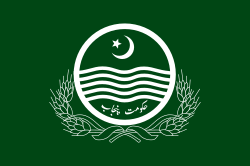Government of Punjab, Pakistan
 From Wikipedia - Reading time: 8 min
From Wikipedia - Reading time: 8 min
 Provincial Government Seal | |
 Provincial Government Flag | |
| Seat of government | Lahore |
|---|---|
| Legislature | |
| Assembly | |
| Speaker | Malik Ahmad Khan |
| Members | 371 |
| Executive | |
| Governor | Sardar Saleem Haider Khan |
| Chief Secretary | Zahid Akhtar Zaman[1] |
| Chief Minister | Maryam Nawaz |
| Judiciary | |
| High Court | Lahore High Court |
| Chief justice of High Court | Malik Shehzad Ahmed Khan |
| Website | www |
The Government of the Punjab (Punjabi, Urdu: حکومت پنجاب) is the provincial government of the Pakistani province of the Punjab. It is based in Lahore, the provincial capital. Its powers and structure are set out in the provisions of the Constitution, in which 41 districts come under its authority and jurisdiction. The government includes the cabinet, selected from members the Punjab Provincial Assembly, and the non-political civil staff within each department. The province is governed by a unicameral legislature with the head of government known as the Chief Minister. The Chief Minister, invariably the leader of a political party represented in the Assembly, selects members of the Cabinet. The Chief Minister and Cabinet are thus responsible for the functioning of government and are entitled to remain in office so long as it maintains the confidence of the elected Assembly. The head of the province is known as the Governor, appointed by the federal government, on behalf of the President. The administrative and executive boss of the province is the Chief Secretary Punjab and they head all the provincial departments and the provincial cabinet.
The Punjab province is the country's most populous region and is home to the Punjabis and various other groups. Neighbouring provinces of Pakistan are Sindh to the south, Balochistan to the south-west and the Khyber Pakhtunkhwa to the north-west, as well as Azad Jammu and Kashmir to the north and Islamabad Capital Territory to the north-west. It also shares International border with Indian states of Punjab and Rajasthan to the east and Indian-administered Jammu and Kashmir to the north. The main languages are Punjabi and Urdu and the provincial capital is Lahore. The name Punjab literally translates from Persian into the words 'Panj' (پانج) five, and 'Aab' (آب) water respectively, which can be translated as "five water" (hence the poetic name land of the five rivers), referring to the Beas, Ravi, Sutlej, Chenab and Jhelum rivers. Part of the Indus river also lies in Punjab, but it is not considered one of the "five" rivers.
Departments
[edit]There are 41 departments in the Punjab government. Each Department is headed by a provincial Minister (elected member of the provincial assembly) and a provincial Secretary (a civil servant of usually BPS-20, 21, or BPS-22). All ministers and Secretaries report to the Chief Minister and Chief Secretary, who are the Chief Executive. The Chief Secretary Punjab is a BPS-22 grade bureaucrat. The Chief Secretary is appointed by the Prime Minister of Pakistan.
In addition to these departments, there are several Autonomous Bodies and Attached Departments that report directly to either the Secretaries or the Chief Secretary.[2] Punjab is the largest Province by population. For better management, Sub Secretariat and Additional Inspector General (IG) South Punjab office in Multan was established by the government.
List of departments
[edit]- Planning & Development Board
- Planning & Development Department
- Services, General Administration, Coordination Department
- Services Wing
- General Administration Wing
- Inter Provincial Coordination Wing
- I&C Wing
- Training Management & Research Management Wing
- Anti-Corruption Establishment
- Local Government and Community Development Department
- Home Department
- Chief Minister's Inspection, Enquiries & Implementation Team
- Universities and Boards Department
- Food Department
- Finance Department
- Energy Department
- Health Department
- Communication and Works Department
- Culture, Tourism, Antiquities & Archives Department
- Works & Services Department
- Information and culture Department
- Excise and taxation department
- Population Welfare Department
- Labor & Human Resources Department
- Law & Parliamentary Affairs Department
- Irrigation Department
- Highway Department
- Agriculture Department
- Literacy & non-formal basic education department
- Forestry, Wildlife and Fisheries department
- Information, Science & Technology Department
- Cooperative Department
- Women Development Department
- Transport & Mass Transit Department
- Industries, commerce and investment department
- Human Settlement Department
- Social Welfare Department
- Mines & Minerals Development Department
- Rehabilitation Department
- Sports & Youth Affairs Department
- Housing, Urban Development, and Public Health Engineering Department
- Higher Education Department
- School Education Department
- Environment, Climate Change & Coastal Development Department
- Investment Department
- Auqaf and Religious Affairs Department
- Human Rights and Minorities Affairs Department
Autonomous Bodies and Attached Departments
[edit]- Punjab Information Technology Board
- Punjab Prisons (Pakistan)
- Punjab Higher Education Commission
- Punjab Commission on the Status of Women
- Punjab Khal Panchayat Authority
- Punjab Masstransit Authority
- Punjab Food Authority
- Punjab Forensic Science Agency
- Punjab Employees Social Security Institution (PESSI)
Legislature
[edit]The Punjab Assembly is a unicameral legislature with 297 elected members, 66 seats reserved for women and 8 seats reserved for non-Muslims)[3]
See also
[edit]- Governor of Punjab, Pakistan
- Chief Minister of Punjab (Pakistan)
- Speaker of the Provincial Assembly of Punjab
- Leader of the Opposition Punjab
- Chief Secretary Punjab
References
[edit]- ^ "Zahid Akhtar Zaman Assumes Charge as Chief Secretary Punjab". punjab.gov.pk. Retrieved 2023-05-10.
- ^ "Provincial Departments | Punjab Portal". punjab.gov.pk. Archived from the original on 2015-01-23. Retrieved 2014-07-22.
- ^ "Punjab Assembly". www.pap.gov.pk. Archived from the original on 30 July 2018. Retrieved 6 June 2020.
 KSF
KSF